Dinosaurs: India
This is a collection of articles archived for the excellence of their content. |
Contents |
Eggs
MP
Bagh
Anand Mohan J, December 30, 2023: The Indian Express
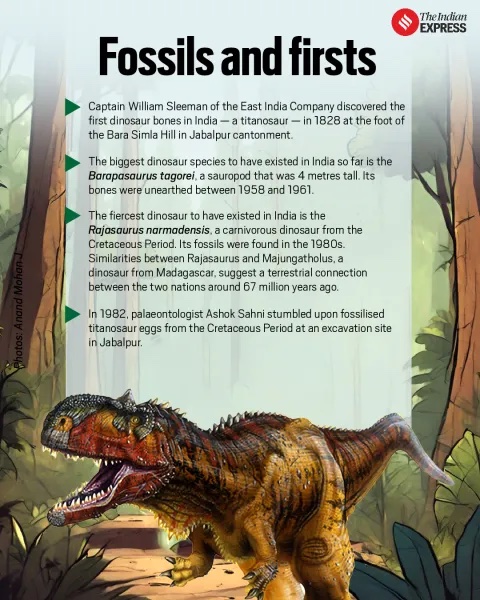
From: Anand Mohan J, December 30, 2023: The Indian Express

From: Anand Mohan J, December 30, 2023: The Indian Express
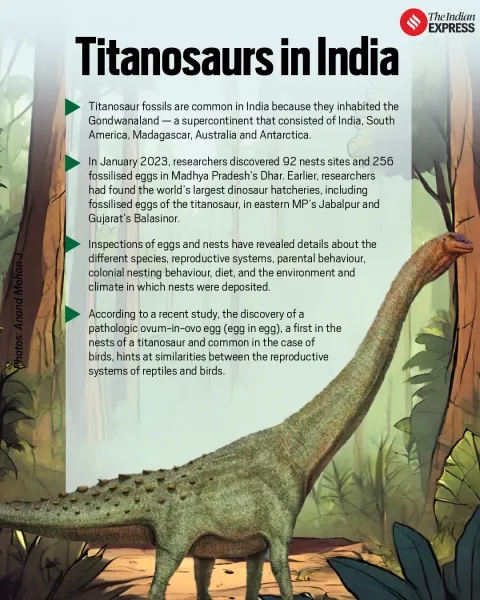
From: Anand Mohan J, December 30, 2023: The Indian Express
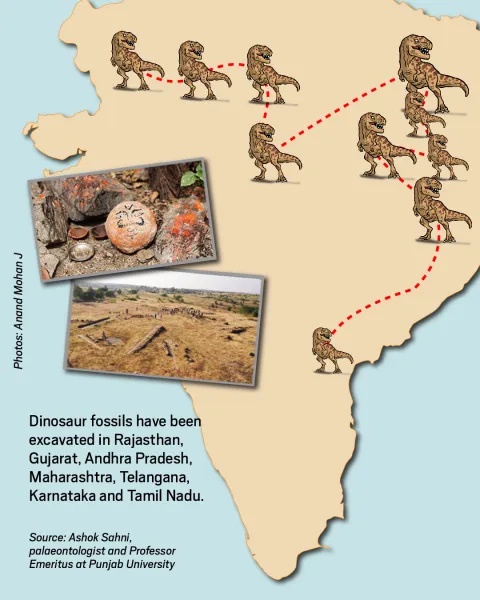
From: Anand Mohan J, December 30, 2023: The Indian Express
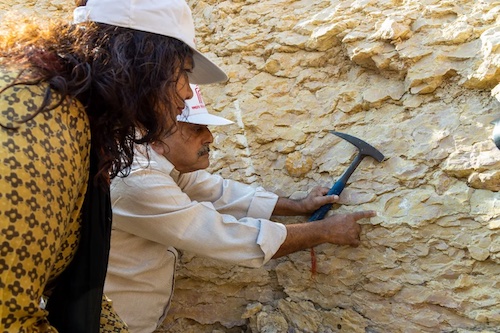
From: Anand Mohan J, December 30, 2023: The Indian Express
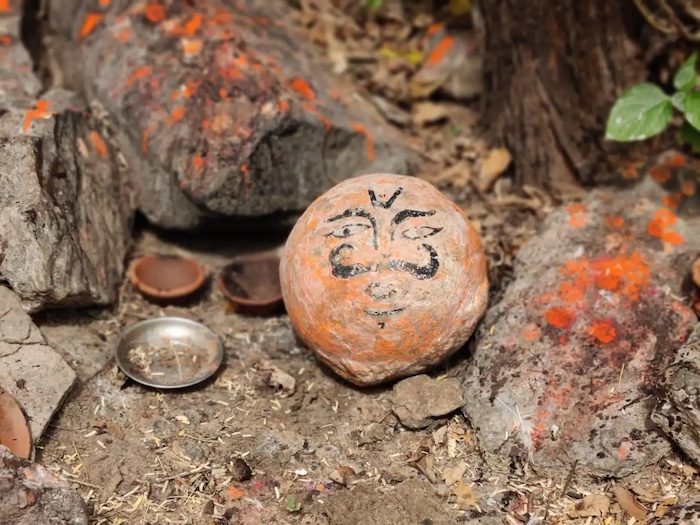
From: Anand Mohan J, December 30, 2023: The Indian Express
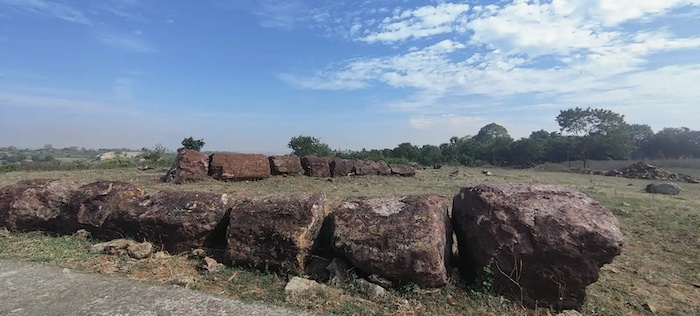
From: Anand Mohan J, December 30, 2023: The Indian Express

From: Anand Mohan J, December 30, 2023: The Indian Express
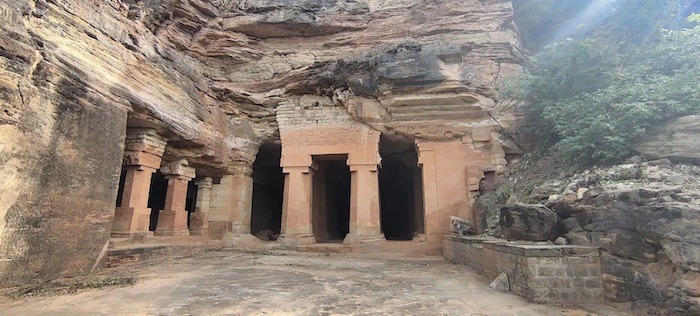
From: Anand Mohan J, December 30, 2023: The Indian Express
As Veshta Mandloi, 38, carefully unwrapped a “tribal god” nestled inside a white cement bag at the dinosaur park bordering the quaint Padlaya village of Madhya Pradesh’s Dhar district, the team of scientists from Lucknow’s Birbal Sahni Institute of Palaeosciences (BSIP) held their collective breaths.
Just like their ancestors worshipped ancient stones as deities, generations of Bhils had worshipped this sun-baked, reddish-brown Kakad Bhairav or Bhilat Baba. Sacrifices of chickens and sheep marked their whispered pleas to the roughly oval-shaped deity — whose weathered face is adorned with a black tilak and a handlebar moustache — for bountiful harvests and healthy livestock.
Palaeontologists, however, confirmed recently that the revered ‘Kakad Bhairav’ was in fact a 66-million-year-old fossilised egg of a titanosaur, a herbivorous dinosaur.
Since the 1980s, discoveries like sauropod bones, fossilised dinosaur eggs and extinct marine creatures paint a vivid picture of the area’s undiscovered ancient past. Eminent palaeontologist Ashok Sahni says India has the “largest-of-its-kind dinosaur hatchery on Earth” that stretches 10,000 sq km across Gujarat, Madhya Pradesh, Maharashtra and Andhra Pradesh.
Over 256 fossilised dinosaur eggs have been unearthed in Madhya Pradesh’s Bagh so far, with 20 nests unearthed recently. The fossilised titanosaur egg is in a vault at the local forest office, while the others have been donated to museums and government facilities.
For years, scientists had been attempting to prove that the Bhil deity was, in fact, a fossilised dinosaur egg. A 2023 research paper proved just that. Tribes that resided in the Narmada Valley worshipped fossilised Titanosaurus eggs, having cattle jump over them for healthy offspring or performing animal sacrifices before harvests.
Mandloi, one of the only three watchmen guarding the 89-hectare Dinosaur Fossil National Park in Bagh, told The Indian Express, “For over five years now, scientists have been calling our Gods dinosaur eggs and taking them away (for research and safety). While I accept their ideas, some villagers don’t. For us, these stones are our Kakad Bhairav. He protects our village and makes our wishes come true. I hope the villagers will see the truth regarding the eggs and we can all come together one day to save our national treasures.”
The latest discovery, scientists hope, will give a fillip to their nomination for India’s first UNESCO Global Geopark tag.
Awarded by the United Nations’ body since 2015, the geopark tag is given to territories for sites with global relevance to geology, geomorphology or palaeontology. If selected, the Bagh site will join a select club of 195 UNESCO geoparks in 48 countries. As it lies in waiting, Madhya Pradesh and BSIP have partnered to transform the dinosaur park into the nation’s first geopark.
In Bagh, fossil conservation is synonymous with a determined physics teacher from the nearby Manawar district. Vishal Verma is responsible for single-handedly safeguarding over 100 fossilised dinosaur eggs and countless other ancient treasures.
State Ecotourism Board CEO Sameeta Rajora, who roped in scientists to evaluate Bagh’s scientific and evolutionary significance, said, “Imagine carrying sacks of rocks home; no mother would approve. Verma’s efforts were funded on his own, and he was honest and worked selflessly.”
Fossilised treasures in clear jars
The unassuming one-room house in a residential colony in Manawar, 76 km from Bagh, is the last place one would look at in search of priceless evolutionary wonders. Though two sets of chairs and mattresses in the humble house are caked in dust, the real treasure that crowds the room is safely ensconced in crystal clear jars nestled on a time-worn wooden shelf.
These fossilised treasures range from rare ammonites (sea creatures with spiral shells that went extinct 66 million years ago), whose stories are etched in the ridges of their handed shells, to shark teeth and massive titanosaurs eggs.
Cradling a fossil in his palm and wearing a utility vest, Verma, 53, looks the part of a palaeontologist. As the light glints off the fossil’s ancient surface, he murmurs, “This Cidaris (sea urchin)… isn’t it beautiful? I started my journey with this.”
Besides his boyhood love for vibrant stones and dinosaur depictions in Phantom, he says his father’s job with irrigation departments near Narmada river towns in Dhar helped preserve his love for ancient treasures. “The main character in the comic book (Phantom) sparked my love for dinosaurs,” says Verma.
In Narmada valley, where he grew up, Narmadia Brahmins revered Hemiaster stones (fossilised ammonites).
“Later, at the Man Dam site (in Dhar), when I was in college, I spotted a Cidaris fossil. I mistook it for a tortoise fossil at first…I was hooked,” he says.
Bones and a town rechristened
Though Verma wasn’t the first to discover dinosaur fossils in MP or the country, he remains a significant part of a legacy of fossil conservators in India.
In fact, it was an English captain who excavated India’s first dinosaur bones. Captain William Sleeman, posted in the Narmada Valley, discovered the skeletal remains in Jabalpur cantonment’s Bara Simla Hill in 1828. As a tribute, a town in MP, 40 km away from Bagh, was rechristened as Sleemanabad.
Fast forward 150 years, when the first dinosaur eggs in India were found — once again in Jabalpur — in 1982. Eminent palaeontologist Sahni made the serendipitous discovery while stooping to tie his shoelaces. Sitting there, etched in rocks in the middle of the site were fossilised titanosaurus eggs.
Currently the Professor Emeritus at Panjab University, Sahni would be a part of the team that pieced together the bones of India’s newest species of carnivorous dinosaur, Rajasaurus narmadensis, in 2003.
Explaining the importance of the discoveries of fossilised dinosaur eggs, Sahni told The Indian Express, “There are six types of eggs. There may have been six or more types of dinosaurs that laid eggs… Over the years most nests were vandalised and very little remains… Some eggs have been misplaced or stolen… Vishal (Verma) has really guarded this place…I have written many research papers with him.”
Around 1996, sauropod remains were found in Bagh, setting off a frenzy. Forest officials said, “Poachers stole valuable wood log fossils that were used to make decorative plates. They also destroyed rock structures and used them as construction material. Even eggs were stolen from the region.”
As access roads to Bagh became bandit havens, apprehensive villagers, fearing land grab, would get into angry arguments with government officials. Around this time, Verma’s exhibition of fossils attracted the attention of Rajora, then a Divisional Forest Officer (DFO) in Dhar, and her husband, who was the Collector of Dhar.
“Curiosity drew us in,” Rajora recalls. “We witnessed Bagh’s beauty… The evidence of prehistoric tectonic movements in the form of rocks etched with ripples, prehistoric seas and mud volcanoes.”
In the backdrop of fossil vandalism and theft, Rajora eventually helped establish the Ashmadha Jeevamsa Museum in Mandu. However, conservation efforts floundered due to dwindling government support.
Meanwhile, though Verma focused on teaching physics, his passion for palaeontology was preserved on a shoestring budget of Rs 1,200 per month from his own salary and a growing collection of marine fossils. Then, in 2007, a visiting PhD scholar sparked new hope. While guiding him to Bagh, Verma stumbled upon 100 loose titanosaurus eggs. As excavations revealed a massive nest, his excitement turned to dread.
“The whole area would have been dug up by fossil hunters. So I borrowed money to hire a JCB (an excavator) and a truck. We had barely loaded the rock structure into the truck and reached Mandu museum, when the truck’s chassis caved in and got destroyed. I ended up incurring a heavy debt,” Verma recalls.
Though a grand ceremony attended by officials and scientists oversaw the donation of the eggs to the Mandu museum, Verma’s triumph turned into despair. “Tents had been erected for the ceremony, but everyone got soaked in the rain. Meanwhile, I was stuck with a huge loan. There seemed to be no point in living,” Verma says.
Though he repaid the debt eventually, he recalls, Bagh grew tense. Scientists were met with stone-wielding villagers, forcing Verma to adopt unconventional but frowned-upon methods to keep palaeontology alive in Bagh — paying children to collect shark teeth and offering locals Rs 1,000 per egg.
“Poachers were winning their hearts with cash,” he says. “Every Friday, the children came (to me) with jars full of shark teeth. I was scared that if I did not pay them, they would sell them to poachers…Eventually, I took a loan of Rs 5 lakh.”
And yet, Verma has no regrets. “Museums across the state are showcasing Bagh’s wonders,” he asserts. “Now, I dream of returning the fossils to their rightful place, a geo-site where the tribals can witness their heritage firsthand.”
Rocks that were once trees
Giant sun-bleached boulders slumber among the rolling hills at Bagh’s dinosaur park. These aren’t mere rocks but ancient trees from a pre-human epoch. Dotting the landscape are rocks etched with marine fossils or jutting shark teeth, and others with patterns crisscrossing the surface, giving crucial hints to the cataclysmic forces that wiped off most life forms from the planet millions of years ago.
Palaeontologist Sahni paints a vivid picture of India’s Cretaceous dinosaurs in his book, Dinosaurs of India. He describes them as the most widespread of all Indian dinosaurs, living during a tumultuous period of continental drift and volcanic activity, which is said to have shaped this region.
Explaining the importance of the research undertaken in this region, Mahesh Thakar, the director at BSIP, says, “These fossils belong to the Cretaceous Period, around the time when dinosaurs went extinct. Research shows (that it took place) after a volcanic eruption happened, because of which the Deccan Plateau was formed. We think it was responsible for the extinction (of dinosaurs) in India. This research helps shed light on that time.”
Today, these priceless evolutionary secrets strewn in the unfenced 89 hectares have been entrusted to three watchful Bhil men, equipped with meagre resources like lathis.
Cutting through the park, ripe with the aroma of wild Tulsi, Bal Singh, 26, recounts his encounters with fossil hunters, “In the night, I get a tip-off. I take off on my bike immediately. Most people are from Bhopal and Indore asking about the site, others want trouble. So far, we have managed to secure the site.”
As the three men work hard to secure the fossils, houses in Padlaya echo with whispers of discontent. Locals say most men migrated to Gujarat due to lack of jobs, leaving only women, children and the aged behind. Then there is Bandar Singh, 60, who claims he quit his job at the park after over unpaid wages. “They call our Gods dinosaur eggs and take them away. We are even denied our rightful wages,” he alleges.
Dhar, MP , 2023
Salil Mekaad, January 21, 2023: The Times of India

From: Salil Mekaad, January 21, 2023: The Times of India
INDORE: Scientists have found 256 fossilised eggs of titanosaur- one of the largest known dinosaurs -- in Dhar district of Madhya Pradesh, drawing parallels between the egg-laying pattern of extinct species to modern day crocodiles and birds.
The fossilised eggs found in 92 titanosaur clutches -- Upper Cretaceous (Maastrichtian) Lameta Formation -- also reveal how the dinosaurs lived, the manner in which they laid eggs away from their habitat area and conditions prevailing during their existence in the area 100.5million to 66 million years ago.
A study, published in open-access journal PLOS ONE by Harsha Dhiman of the University of Delhi, New Delhi and colleagues, opens avenues to additionally understand more about titanosaur palaeobiology and to qualitatively understand preservation and taphonomical aspects of their egg clutches.
Researchers gear up to carry out CT scans of areas
The researchers are now gearing up to carry out CT scans of the area, expecting to find the first dinosaur embryo in India.
"We have found six oospecies. The study of egg-laying patterns showed similarities to that of modern day crocodiles and birds," Harsha Dhiman told TOI.
Crocodiles lay eggs in clutches and bury them. "We found that the titanosaur eggs were laid in clutches and partially buried in shallow pits," she said, adding that both multi-shelled and ovum-in-ovo pathologies have been documented in the eggs. The former is common in both reptile and bird eggs, while the latter has so far only been reported from avian eggs.
University of Delhi geology department head Prof GVR Prasad said the multi-shelled eggs also show that the dinosaurs were under considerable stress. "Such phenomenon happens when a new egg is formed over the older one, which somehow is not laid and returns to the ovary. It can happen due to external stress - food scarcity, changes in climate, floods or events that badly affect the animals," he said.
Prof Prasad said the study gives strong evidence of dinosaurs falling under the clade archosauria - crocodiles and birds are the only living representatives of the category.
The researchers carried out investigations between 2017 and 2020 and found extensive hatcheries of dinosaurs in Bagh and Kukshi areas in Dhar district - in villages Akhada, Dholiya Raipuriya, Jhaba, Jamniapura, and Padlya. Experts are working on getting a Unesco Global Geopark status for the area to pave the way for further studies.
The recent study did not find body and bone fossils of dinosaurs near the nesting sites. "This indicates that the titanosaurs laid eggs at places other than where they lived, " said Dhiman, adding the egg-laying pattern seen in the fossils shows that the nests were not supervised.
"It also suggests that micro-excavation is needed to ascertain if body fossils can also be found in the area, to give a new direction to the theory," she said.
Now, the researchers are chalking out plans to go deeper into the fossils and expect surprises. "If we find an embryo, it would be the first in India," Dhiman said.
The researchers found diversity in the form of six oospecies. But Prof Prasad says that it cannot be concluded that the same diversity existed among the dinosaurs. It must be corroborated with body fossils.
"If skeletal remains inside the eggs, embryo could be found, it would give better clarity," Prof Prasad said.
The researchers are now trying to locate micro CT scan facilities in India that could give better 3D images to study the eggs without damaging them.
Dhar: Padlya
Mohita Tewari, Dec 19, 2023: The Times of India
Holy ‘stone balls’ turn out to be fossilised dino eggs
Lucknow : Faith can move mountains. In MP’s Dhar, it was moving palm-sized “stone balls” till a band of experts determined them to be fossilised dinosaur eggs.
Vesta Mandaloi (40) of Padlya village had been worshipping these balls as “Kakar Bhairav” following his forefathers’ belief that the “kuldevta (totem)” would protect his farmland and cattle from problems and misfortunes. “Kakar” means land or farm and “Bhairav” denotes God. Like Mandaloi, many others worshipped similar balls that they found during digging activities in Dhar and adjoining districts. It was only when ex perts from Lucknow’s Birbal Sahni Institute of Palaeosciences made a field visit recently to the area that the residents learnt the balls they’d been worshipping were fossilised eggs of dinosaurs’ Titanosaurus species.
Will try to get Unesco tag for Dhar district, say officials
The team of paleo scientists from BSIP’s Centre for Promotion of Geoheritage and Geotourism (CPGG), led by director MG Thakkar, visited Dhar to prepare a roadmap for preservation of all such fossils.
With the support of CEO of MP’s ecotourism development board Sameeta Rajora, local paleontology expert Vishal Verma and MP forest officials, the BSIP team conducted field visits and talked to locals about the conservation of the fossils. “We are planning to get Dhar district recognised as a Global Geopark by Unesco. We are trying to preserve all fossils and geoheritage sites. Paleontology expert Vishal Verma informed us that so far around 256 dinosaur eggs have been found in a stretch of 120km in Dhar district. At least 20 new dino nesting sites were discovered in June this year,” said BSIP director Thakkar.
“During the visit, a scientific study of fossils was carried out. Our senior scientist Shilpa Pandey interacted with residents and informed them that their ‘kuldevta’ is also a dinosaur egg,” Thakkar added.
Shilpa, also convener of CPGG, found that some people had made facial features on the dino eggs to worship them. During Diwali, Shilpa said, people made pregnant cattle jump over the “stone balls”, believing it would bring healthy offspring. “Our director asked the residents to contribute to developing the fossil park and told them that the fossils found in the region are our national heritage. The director also briefed officials on how BSIP can contribute to developing the park,” she said. A member of the CPGG team, Vivesh V Kapur, stressed that the locals’ religious beliefs played a crucial role in preserving the dino eggs.
Mandla, MP: 2020
P Naveen, November 7, 2020: The Times of India
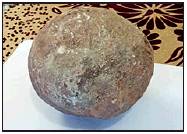
From: P Naveen, November 7, 2020: The Times of India
A child playing with ‘round stones’ and a Jurassicbuff government schoolteacher crossed paths in a farm in Mandla district of Madhya Pradesh, leading to the discovery of 65-million-year-old dinosaur eggs of a species never before seen in India.
The site is located around 80km from Bara Simla hills of Jabalpur, where the first dinosaur fossils in Narmada Valley were discovered in 1828 by Captain William Sleeman. Since then, fossils of a variety of dinosaurs have been found in various parts of Narmada valley.
The latest find was purely by chance. “I was out on a morning walk near Mohantola locality when I saw a young boy playing with a ball-shaped stone. When I asked him to give it to me, he refused and said I could find more such ‘balls’ near a pond, which was being dug. I followed his directions and reached the site where I found a cluster of seven such ‘balls’. I knew instantly that they were fossilised eggs,” Prashant Shrivastava, a 49-year-old teacher from Mandla, told TOI.
The pond is in someone’s farmland. The site where the eggs were found was a dinosaur nest, said Prof P K Kathal, a palaeontologist from the Centre of Advanced Study in Geology at Dr Harisingh Gour Vishwavidyalaya, who authenticated the fossilised eggs. “The eggs are from the Upper Cretaceous period, and seem to belong to a new species of beaked or sauropod dinosaur hitherto unknown in India,” Kathal said.
Footprints
Rajasthan, 2016
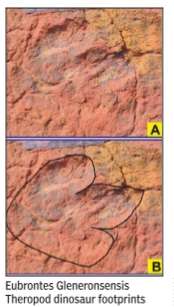
The Times of India, Jun 13 2016
Vimal Bhatia
150m-year-old dino footprints found in Rajasthan
A team from the geological department of Jainarayan Vyas University , Jodhpur, has discovered 150 million-year-old footprints of Eubrontes Gleneronsensis Theropod dinosaurs in Lathi formation in Jaisalmer district. These carnivores were 1-3 metres in height and seem to belong to the coastal environment.
Fossils of Eubrontes Theropod dinosaurs have been found worldwide in France, Poland, Slovakia, Italy, Spain, Sweden, Australia and the US. The footprints of Eubrontes Gleneronsensis Theropod dinosaurs have been discovered for the first time by Dr Virendra Singh Parihar, Dr Suresh Chandra Mathur and Dr Shankar Lal Nama.
“Morphologically , footprints of Eubrontes Gleneronsesis Theropod dinosaurs are large about 30 cm long, tridactyle, strong with thick toes. Their body is estimated to be 1-3m tall and 5-7m in length,“ Parihar said.“The Katrol formation of Kutch basin and Baisakhi formation of Jaisalmer basin are potential sites for remains of dinosaurs.“ This discovery might open new vistas in searching dinosaur fossils in equivalent rocks. The finding is important as professor Mathur along with his team discovered mass mortality horizon (bone bed) containing fossils of dinosaur, crocodile, gastropods and fishes from Fategarh formation with magnetic spherules. Mathur said this discovery shows the cause and effect relationship and can help to solve the mystery of the extinction of dinosaurs.
Fossils
Jaisalmer 2023
Mohita Tewari, August 8, 2023: The Times of India

From: Mohita Tewari, August 8, 2023: The Times of India
Lucknow : Scientists from IIT-Roorkee and Geological Survey of India (GSI) have discovered the oldest fossil remains of a long-necked, plant-eating dicraeosaurid dinosaur in Jaisalmer, suggesting that India was a major centre of dinosaur evolution.
The study published in ‘Scientific Reports’, an international journal by publishers of Nature, reveals that the remains are 167 million years old and belong to a new species, unknown to scientists thus far. It has been named ‘Tharosaurus indicus’, the first name referring to the ‘Thar desert’ where the fossils were found, and the second after its country of origin.
According to the scientists, fossils of dicraeosaurid dinosaurs have been found previously in North and South Americas, Africa and China, but such fossils were not known from India. “A systematic fossil exploration and excavation programme initiated by GSI in 2018 in the Middle Jurassic rocks in the Jaisalmer region of Rajasthan has led to this discovery,” said Prof Sunil Bajpai, chair professor of vertebrate paleontology in the department of earth sciences at IIT-Roorkee, who carried out a detailed study of the fossils for around five years along with his colleague Debajit Datta, a national postdoctoral fellow.
The rocks in which the fossils were found are dated to be around 167 million years old, which makes this new Indian sauropod not only the oldest known dicraeosaurid but also globally the oldest diplodocoid (broader group which includes dicraeosaurids and other closely related sauropods). Theories so far had suggested that the oldest dicraeosaurid was from China (about 166-164 million years old).